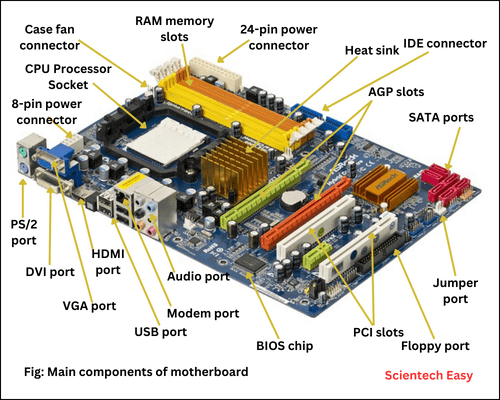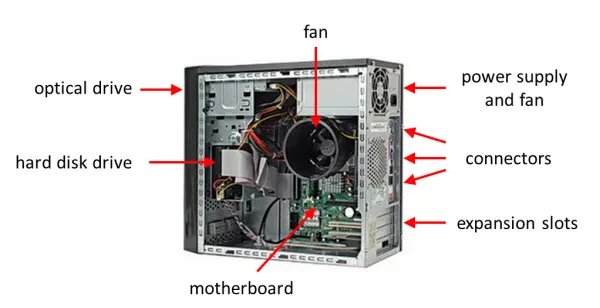PC Hardware Trouble shooting:
Components of a CPU:
1. Motherboard:
A motherboard is the main circuit board in a computer system. It connects all of the internal components, like the memory, processor, graphics card and other hardware. Its also known as PCB (Printed circuit board).
Some components of Motherboard:
-
Processor Socket:
It is mechanical and electrical interface on a motherboard that securely connects a central processing unit (CPU) to the rest of the computer system. -
CMOS backup battery:
It is a small, coin-shaped battery that helps to keep the date and time accurate on computer. It ensures these settings are retained even when the computer is turned off and disconnected from a power source. -
LAN (Local area network):
It is the built-in Ethernet port that allows the computer to connect to a wired local area network for internet and data communication. -
RAM Slots:
Slots for installing RAM (Random Access Memory) modules. -
Chipset
Communication between Northbridge (handles CPU, RAM, GPU communication) and Southbridge (handles I/O, storage devices). - Expansion Slots:
- Expansion slots on a motherboard are sockets designed to accommodate expansion cards, which add or enhance a computer’s functionality
- Common types: PCI.
-
Power Connectors
Connects to the power supply unit (PSU). -
Storage Connectors:
SATA ports for connecting hard drives (HDD), solid-state drives (SSD), and optical drives. -
BIOS Chip:
Firmware that initializes hardware during startup and provides runtime services for the OS. - Input/Output (I/O) Ports:
- Located on the back of the motherboard.
- Includes USB ports, audio jacks, Ethernet, HDMI, DisplayPort, PS/2, etc.
- Heat Sinks:
Passive cooling components for chipsets and VRMs.

2. Fan:
- Used for cooling the motherboard.
- Prevents overheatingt.
3. Power Supply with Fan
- Provides electrical power to all parts of the computer.
- Has a built-in fan to cool itself & CPU cabinet during operation.
- Converts electricity from the wall (AC) to usable computer power (DC).
4. Connectors
- Cables and plugs that connect components to the power supply and motherboard.
5. Expansion Slots
- Used to insert extra cards like:
- Graphics cards
- Sound cards
- Wi-Fi/network cards
6. Hard Disk Drive (HDD):
- Stores data, software, and the operating system.
- Located under the optical drive in the cabinet.
7. Optical Drive (CD/DVD Drive):
- Used to read/write CDs and DVDs
How to locate components of a CPU?
- Look for the power supply with fan (usually at the back top or bottom of the cabinet).
- In front of it is the optical drive.
- On it’s side is the Motherboard.
- Below the optical drive is the hard disk drive.

Difference between RAM and Cache memory:
| Feature | RAM (Random Access Memory) | Cache Memory |
|---|---|---|
| Purpose | It holds programs and data that are currently executed by the CPU. | It holds frequently used data by the CPU. |
| Speed | Slower than cache | Much faster than RAM |
| Size | Larger (in GBs, e.g., 8GB, 16GB) | Smaller than RAM |
Why do we need Cache memory?
- It helps the CPU work faster and more efficiently by reducing the time it takes to access data.
- Cache memory is much faster than RAM.
- It stores frequently used instructions and data, so the CPU doesn’t have to wait for slower RAM.
- Without cache, the Processor would waste cycles.
So it is used to remove mismatch between RAM and Processor speed.
Difference between RAM and Hard Disk:
| Feature | RAM (Random Access Memory) | Hard Disk |
|---|---|---|
| Purpose | Temporary memory for currently running programs | Permanent storage for files, software, and OS |
| Storage Type | Temporary (loses data when off) | Permanent (keeps data when off) |
| Speed | Much faster | Slower compared to RAM |
| Storage Capacity | Smaller | Larger |
| Access Method | Direct access by CPU | Slower access through file system |
| Cost | Expensive | Cheaper |
| Function | Helps run active programs and processes | Stores data, files, OS, and installed programs |
Process of Booting: | Step | Description | | ———————————————– | —————————————————————————————————————————– | | 1. Power On | You press the power button. Electricity flows to all components. | | 2. Signal to RAM (Firmware loads Bootstrap) | The BIOS/UEFI firmware stored in ROM sends a signal to RAM and loads Bootstrap Loader. | | 3. Hard Disk Copy Transferred to RAM | The Bootstrap Loader finds the operating system (OS) on the hard disk and copies essential OS files into RAM. | | 4. OS Starts (OS gets control) | Once the OS is loaded into RAM, it takes over the system. The desktop/interface appears, and the system is ready for use. |